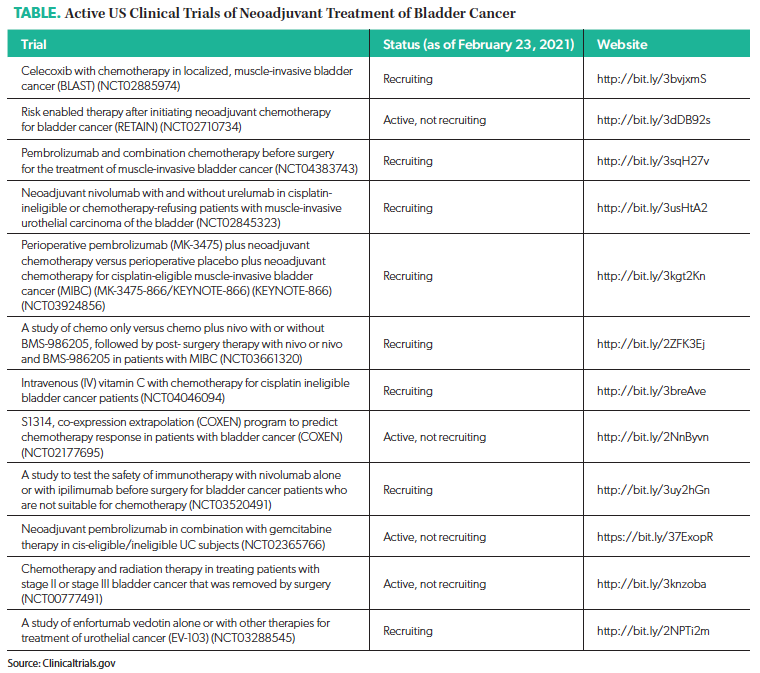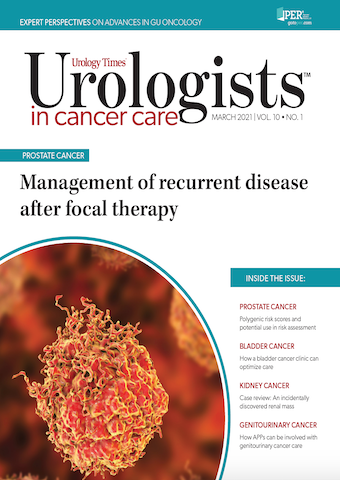Publication
Article
Urology Times Urologists in Cancer Care
How a bladder cancer clinic can optimize care
Author(s):
Case study of a patient with muscle-invasive bladder cancer.
THE CASE
A 63-year-old Caucasian man presents to urology with painless gross hematuria of 2 days’ duration. He reports total hematuria, no clots, and blood is bright red and now intermittent. He has no personal history of nephrolithiasis, and was a 1-pack-per-day (PPD) smoker for 25 years. AUA symptom score: 9.
NKDA
Medications: baby ASA qd, lisinopril 20 mg daily
Past medical history: (+) hypertension, (+) s/p laparoscopic cholecystectomy x 8 years, s/p appendectomy (age 12)
Social history: 1 PPD smoker x 25 years, social ETOH
Family history: noncontributory
PE: Prostate approximately 40 g, no suspicious nodules
Cysto (office): (+) sessile lesion
to right lateral wall, ~3.5 cm
CT (intravenous contrast): normal upper tracts, no filling defects, thickening of right bladder wall
TURBT/EUA: (+) high-grade urothelial carcinoma, (+) invasion through lamina propria and into muscularis mucosa. Not fixed.
Staging work-up (CT pelvis, abdominal, chest; bone scan): negative
(Provided by Raoul S. Concepcion, MD, FACS)
Patients with newly diagnosed muscle-invasive bladder cancer (MIBC) are quickly referred into our practice’s Comprehensive Bladder Cancer Clinic (CBCC). The importance of creating a program like the CBCC to optimize care for these patients cannot be overstated and requires identifying a team of experts and specialists in bladder cancer and centralizing their care. Prior to their CBCC appointments, patients are contacted by the CBCC nurse navigator and receive literature to help them understand the diagnosis, management, and prognosis of MIBC. In addition, they learn about the members of the multidisciplinary CBCC team of urologic oncologists, medical oncologists, enterostomal therapists, visiting nurses, and oncology nutritionists who may care for them.
Prior to their initial CBCC visit, I ensure that patients have had recent clinical and radiographic staging, which this patient has obtained. In addition, I use commercially available genomic testing to determine which patients may benefit from neoadjuvant cisplatin-based combination chemotherapy (NAC) by analyzing tumor molecular subtyping from the transurethral resection of the bladder tumor specimen.1 This allows me to determine whether neoadjuvant therapy is appropriate or whether my patient should move immediately
to cystectomy.

There are numerous clinical trials for both cisplatin-eligible and -ineligible patients and I strongly encourage patients to consider these (Table). In centers where clinical trials are unavailable, the standard of care is to offer cisplatin-based neoadjuvant chemotherapy; notably, National Comprehensive Cancer Network guidelines do not recommend noncisplatin-based regimens because of their lower response rates and higher rates of hematologic toxicities.2 Patients ineligible for cisplatin should proceed directly to cystectomy or, if available, be considered for referral to sites with clinical trials for cisplatin-ineligible patients. All patients with MIBC are presented at a multidisciplinary genitourinary tumor board for confirmation of pathology, staging, and the treatment plan.
This patient has an excellent performance status and would be eligible for NAC followed by radical cystectomy. I generally reserve bladder-sparing trimodal therapy (maximal transurethral resection of the bladder tumor followed by concurrent chemoradiotherapy) for patients with strong preferences against cystectomy or in individuals medically unfit for cystectomy.
I feel strongly that most patients can tolerate either of these approaches; unfortunately, studies have demonstrated that almost half of all patients with MIBC do not receive curative-intent treatment.3
One of the most critical roles for the urologic oncologist in the CBCC is to educate the patient and advocate for a comprehensive treatment plan. Some individuals, like this one, have just been given a diagnosis of bladder cancer and are new to the diagnosis and treatment options. Others may be in the 15% to 20% of patients previously diagnosed with non–muscle-invasive bladder cancer who progress to MIBC following years of bladder cancer treatment and surveillance.4 I find that the discussion about management of MIBC is different for these 2 patient cohorts. It is critical that other key decision makers (eg, partners, children) are present because the success of peri- and postoperative recovery is often dependent on the patient’s support system. I also emphasize that although the patient should take time to make a thoughtful decision, the clock is ticking because a delay in care from initial diagnosis to surgery is associated with worse overall survival in patients with MIBC.5
Once the decision about neoadjuvant treatment has been determined, the plan for surgical approach and urinary diversion is discussed. The surgical approach is best determined by surgeon experience; a Cochrane review of multiple randomized clinical trials comparing robotic and open cystectomy essentially demonstrated equivalent outcomes for oncologic outcomes and complications other than blood transfusion and time to discharge.6 In our CBCC, robotic cystectomy is the preferred surgical approach in over 90% of our patients. We have not found that prior intra-abdominal surgery or locally advanced disease obviates the ability to perform the surgery robotically.
Pelvic lymph node dissection (PLND) is a critical step of the operation and I utilize a risk-stratified approach to determining the extent of the dissection. If there is no clinical evidence of extravesical extension and no clinically suspicious lymph nodes on imaging or at the time of surgery, a standard (obturator, internal, and external iliac) lymph node dissection is performed. If there is suspicion of T3 or T4 disease or malignant lymph node involvement, an extended PLND is performed including removal of the internal iliac and presacral nodes. The data for superextended lymph node dissection of the nodes along the inferior mesenteric artery demonstrate limited utility and benefit, and I do not advocate this routinely.
Urinary diversion selection should be independent of the surgical approach and determined by patient preference with input from the urologist based on patient gender, habitus, and diversion type. I utilize a completely intracorporeal approach for ileal conduit and a hybrid intra- and extracorporeal technique through the extraction incision for a neobladder. For patients who are uncertain about their choice, I routinely have them meet with the enterostomal therapist and speak with patients who have undergone the various diversion types. I also emphasize that the decision regarding diversion type can be made closer to the date of surgery so that patients can begin their neoadjuvant therapy with minimal delay.
In conjunction with our anesthesia colleagues, we utilize enhanced recovery after surgery (ERAS) pathways in the perioperative period. These have been shown to decrease morbidity and complications and reduce hospital stay.
Our approach includes preoperative medical optimization and nutritional education, prehabilitation and physical conditioning, preoperative carbohydrate loading, use of preanesthetic alvimopan, thromboembolic prophylaxis, avoidance of bowel preparation and nasogastric tubes, preventing intraoperative hypothermia, Doppler-directed intraoperative fluid management, non-narcotic analgesia during and after surgery, enteric feeding on the first postoperative day (POD), and early and aggressive mobilization.
Most patients are discharged home between POD 3 and 5 with close observation by visiting nursing specialized in stoma care. Patients are seen postoperatively by members of the CBCC each week for the first month for stent and catheter removal until they are independently managing their urinary diversion.
This patient underwent combination neoadjuvant chemotherapy and immunotherapy as part of a clinical trial. Four weeks after completion of his neoadjuvant treatment, he underwent robotic cystoprostatectomy, standard PLND, and creation of an orthotopic neobladder. He was discharged home on POD 5. He was seen weekly for stent removal, suprapubic tube removal, and then urethral catheter removal. At the end of the first postoperative month, he was tube-free and no longer utilizing visiting nursing services.
References
1. Seiler R, Ashab HAD, Erho N, et al. Impact of molecular subtypes in muscle-invasive bladder cancer on predicting response and survival after neoadjuvant chemotherapy. Eur Urol. 2017;72(4):544-554. doi:10.1016/j.eururo.2017.03.030
2. NCCN. Clinical Practice Guidelines in Oncology. Bladder cancer, version 6.2020. Accessed February 18, 2021. https://www.nccn.org/professionals/physician_gls/pdf/bladder.pdf
3. Gore JL, Litwin MS, Lai J, et al; Urologic Diseases in America Project. Use of radical cystectomy for patients with invasive bladder cancer. J Natl Cancer Inst. 2010;102(11):802-811. doi:10.1093/jnci/djq121
4. Knowles MA, Hurst CD. Molecular biology of bladder cancer: new insights into pathogenesis and clinical diversity. Nat Rev Cancer. 2015;15(1):25-41. doi:10.1038/nrc3817
5. Chu AT, Holt SK, Wright JL, et al. Delays in radical cystectomy for muscle-invasive bladder cancer. Cancer. 2019;125(12):2011-2017. doi:10.1002/cncr.32048
6. Sathianathen NJ, Kalapara A, Frydenberg M, et al. Robotic assisted radical cystectomy vs open radical cystectomy: systematic review and meta-analysis. J Urol. 2019;201(4):715-720. doi:10.1016/j.juro.2018.10.006

Newsletter
Stay current with the latest urology news and practice-changing insights — sign up now for the essential updates every urologist needs.



















